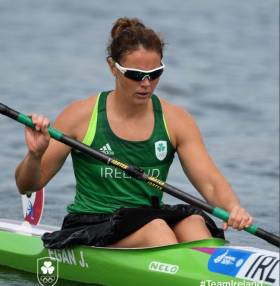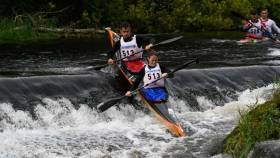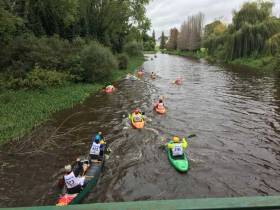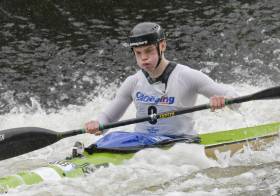Displaying items by tag: Liffey Descent
2024 Liffey Descent Confirmed for Saturday 11 May
The 2024 edition of the iconic Liffey Descent will take place on Saturday 11 May.
Racing the classic 32km route, tackling 10 weirs and taking in the stunning scenery that the counties of Kildare and Dublin have to offer, the race is a standout highlight in the canoeing calendar.
First held in 1960, the Liffey Descent is steeped in history, attracting the entire canoeing community from top-level international racers to those taking on the annual challenge.
And the 2024 race features no shortage of stories within the race.
Mark Henderson continues to fly the flag for disability inclusion in sport. A wheelchair user, Mark completed last years race in a double kayak with a guide but is returning this year with the goal to take on the race solo.
Several international crews are also travelling to compete for the race win, including a former winner from South Africa hoping to retake their crown. The race will also welcome crews from the UK and Australia.
For more race info and entry details, see the Liffey Descent website HERE.
2023 Liffey Descent to Take Place on Saturday 6th May
Canoeing Ireland has announced that the 2023 Liffey Descent will take place on Saturday 6th, May.
The new spring date follows an extensive consultation process and, say organisers, ensures the best possible water levels and weather conditions for one of the biggest canoeing events of the year.
A long-time highlight on both the domestic and international marathon racing calendar, this race promises a return to top-level racing and fantastic community involvement that gives the Liffey Descent its status.
The race will feature the same stunning 30km route along the river Liffey, taking in the beautiful surroundings and the thrills of 10 weirs.
“Extremely low” water levels prompted the cancellation of September's 2022 Liffey Descent canoe and kayak race.
2022 Liffey Descent Cancelled Over ‘Extremely Low’ Water Levels
“Extremely low” water levels have prompted the cancellation of this month’s Liffey Descent canoe and kayak race.
In a statement, organisers said that there is “no hope of of any relieving rainfall according to the long-range forecast” to replenish the reservoir that supplies the River Liffey, which was to see the 62nd Liffey Descent take place on Saturday 10 September.
It marks the second time in two years that the annual canoe and kayak race from Kildare to Islandbridge in the capital has been cancelled, with 2020’s race falling victim to coronavirus restrictions.
“With the best interests of the health, safety and enjoyment of participants we have made the difficult decision to cancel this year’s event,” the statement said.
“We are exploring the option of moving the race to April to alleviate the annual issue with water levels, which have become more problematic in recent years.”
Competitors will be given the option to move their entry to the new date if rescheduling can be confirmed, organisers added.
Young Guns Foley and Thomsen Win at 60th Liffey Descent [UPDATE]
#Canoeing: Ronan Foley (19) and Nikolai Thomsen (18) of Denmark were the fastest home as the Liffey Descent celebrated its 60th birthday today. The 32-kilometre test, with 10 weirs and a portage on the journey from Straffan to the Garda Boat Club in Islandbridge, sometimes rewards experienced competitors, but this was an exception. Both young men were competing for the first time in a K2 (double kayak) on this course, but they took advantage of the fast conditons to win a battle with experienced hands Barry Watkins and Neil Fleming. Foley and Thomsen moved in the final 1,000 metres to win in one hour 46 minutes and 40 seconds. Watkins and Fleming came home in 1:46.49.
The entry of 472 boats was blessed with a beautiful day, and there were some excellent peformances. Jenny Egan continued her record of wins in the mixed K2; she and fiance Jon Simmons were fourth at Lucan weir and fifth overall in a new best time for this boat. Malcolm Banks in the men's over 49 K1, also placed high in the overall rankings, while Peter Egan won the men's K1 on his first attempt at the class.
Liffey Descent 2019, Detailed Results (selected)
K2 – Men’s: 1 Ronan Foley (Salmon Leap CC)/Nikolai Thomsen (Denmark) 1:46.40, 2 Neil Fleming (Celbridge Paddlers)/ Barry Watkins (Salmon Leap CC) 1:46.49, 3 Sebastien Fergauven/Sebastien Jocano (Argentina) 1:47.16. Men’s O39: 1 Simon van Lonkhuyzen/Gary Mawer (Salmon Leap CC) 1:55.59, 2 David Francis/Declan Halton (Salmon Leap CC) 1:59.28, 3 Lutz Erichsen/Peter M. Jensen (Denmark) 2:04.09.
Mixed: 1 Jonathan Simmons/Jenny Egan (Salmon Leap CC) 1:51.52, 2 Deaglan O Drisceoil/Aisling Smith (Salmon Leap CC) 1:57.58, 3 Nicky Cresser/Alison Chmiel (Nottingham CC) 2:07.20.
K1 – Senior Men: 1 Peter Egan (Salmon Leap) 1:57.43, 2 Donnacha Brennan (Thomastown CC) 2:00.22, 3 Odhran McNally (Salmon Leap CC) 2:01.33. O39 men: 1 Dermot Hudson (Salmon Leap CC) 1:59.36, 2 Stewart O’Regan (Salmon Leap CC) 2:04.12, 3 John Parker (Worcester CC) 2:13.19. O49: 1 Malcolm Banks (Salmon Leap CC) 2:02.50, 2 James Butler (Nottingham CC) 2:06.38, 3 Neil Blackman ( Royal Leamington Spa) 2:08.39. Junior men: Senan Forristal (Thomastown Paddlers) 2:01.04, 2 Matthew McCartney (Celbridge Paddlers) 2:08.077, 3 Alex O’Brien (Celbridge Paddlers) 2:20.15.
Senior women: 1 Margaret Farrell 2:56.23, 2 Sara Griffin 3:10.46, 3 Amy Walsh 3:21.38.Junior women: 1 Aoibhin Ni Broin (Galway CC) 2:39.23.
T2 – Sean Martin/Eddie Martin (Piragua Madrid/Richmond CC) 2:14.39, 2 Fergus Cooper/Morgan Cooper (Canoeing Ireland) 2:16.07, 3 Lar O’Brien/Michael O’Farrell (Kilcullen CC) 2:19.00.
Wildwater – Open: 1 Darragh Clarke (Wild Waater KC) 2:15.4, 2 Maggie Dilai (Nottingham KC) 2:17.49, 3 Alex Sheppy (Devizes CC) 2:26.26
K1 Class B – Men: 1 Colin Wong (Canoeing Ireland) 2:29.46, 2 Mark Redmond (Wild Water KC) 2:30.45, 3 Padraig Dunne Athy Rowing and CC) 2:37.25. O39: 1 Gerry Murphy (Canoeing Ireland) 2:32.12, 2 Edward Broekaart (Canoeing Ireland) 2:34.33, 3 Gary McClure (Belfast CC) 2:36.05 Junior men: 1 Cameron Bannatyne (Soar Valley) 2:18.33, 2 Ethan Dowling (Ribbontail Paddlers) 2:47.03, 3 Michael O’Herlihy (Wild Water KC) 2:48.18
K1 Class C: Men: 1 Craig Stratford (Virginia KC) 2:54.10, 2 Brian James (Cabra KC) 2:56.59, 3 Wojciech Szydlo (Silverbridge KC) 2:59.48. O39: 1 Terry Smith (Athy Rowing and CC) 2:37.10, 2 Andrew Redmond (Wild Water KC) 2:39.30 3 Dermot Forristal (Thomastown Paddlers) 2:39.44. Junior men: 1 Daniel Stratford (Virginia KC) 2:38.40, 2 Barry Stratford (Virginia KC) 2:41.29, 3 Alex Russell (Canoeing Ireland) 2:44.35.
Women: 1 Ciara Gurhy (Wild Water KC) 2:47.45, 2 Helen Flanagan (Share Centre) 2:55.53, 3 Yvonne Crosse (Phoenix KC) 3:04.21. O39: 1 Fiona Kelly (Wildwater KC) 2:49.50, 2 Yvonne Kelly Castleknock Community Collge KC) 2:50.38, 3 Mary Fitzgerald (Athy Rowing and CC) 2:58.27. Junior women: 1 Emma Fay (Ribbontail Paddlers) 3:14.20, 2 Rachel Alexander (Virginian KC) 3:20.04.
C1 – 1 Stephen Dunne (Mullingar CC) 3:11.16, 2 Andy Jeffers (Phoenix CC) 3:26.30, 3 Paul Magee (Canoeing Ireland) 4:05.55
C2 - 1 Ben Boland/Roger McClure (Kilkenny Aqua CC) 2:37.26, 2 Gearoid Jones/James Dillon (DIT CC) 2:47.54 3 Gerry Coonan/Gerry O’Brien (Wild Water KC) 3:00.42. C2 (mixed) – 1 Elaine Alexander/Richard Hobson (CANI/Lisburn City Paddlers) 2:57.58, 2 Colin Lively/Jacqui McVicar (Share Centre) 3:06.04, 3 Eamonn Dodd/Lynda Byron (Wild Water KC) 3:15.50.
C3 – 1 D Comerford/S O’Neill/S O’Neill (Thomastown Paddlers) 2:48.24, 2 Y Kalogerakis/ D Holden/B Comerford (Canoeing Ireland) 2:51.20, 3 K Durkan/S Durkan/M Fitzsimon (Celbridge Paddlers) 3:00.20.
Best Club (combined K1 and K2 times) : Salmon Leap Canoe Club, Leixlip
International Trophy: Ireland.
Liffey Descent Set for Busy Sixtieth Birthday
#Rowing: Jenny Egan and Jon Simmons of Salmon Leap Canoe Club defend their mixed K2 title at Saturday’s 60th anniversary Liffey Descent, which starts from Straffan at 12 o'clock and finishes 32 kilometres later at the Garda Boat Club in Islandbridge.
Egan is going for a third consecutive victory in this category - in 2017, she paired up with brother Peter to win in a course record time of 1 hour 55 minutes. Also competing in this category are Deaglan O Drisceoil and Aisling Smith of Salmon Leap, who finished second in the world renowned Sella Marathon in Spain earlier this summer. Both are previous K1 winners.
It will be an eleventh “Liffey” for Egan, who is attempting to win selection for the Tokyo Olympics and spent the summer competing at races around Europe.
Peter Egan, who finished second in men’s K2 last year, goes in K1 this year. Tadhg de Barra and Donnacha Brennan, both from Thomastown Paddlers, look like the other main contenders.
Barry Watkins, another Salmon Leap paddler, won his first K1 title last year, but reverts to K2 this time, where his partner is previous K1 winner Neil Fleming of Celbridge Paddlers. This could prove to be the most competitive class of the day with a number of strong Irish boats as well as at least four entries from the UK, two from Argentina, and one each from Spain, the Czech Republic and Germany.
Among the local entries, former European junior marathon champion Ronan Foley teams up with Nikolai Thomsen of Denmark for his first attempt at senior K2, while Michael Brennan, winner of the open canoe singles last year, takes to the water this time with his Thomastown club mate Anthony Forristal.
After a long dry summer, last year’s Liffey Descent was the driest on record which meant times were slow and fewer recreational boats entered. This year, low water won’t be a problem, thanks to plenty of rainfall in the past few months which means the ESB can release a small flood. Spectators on the banks of the Liffey may have good entertainment on Saturday. Premium spots are at the bridge in Straffan just down from the start and at Lucan weir.
Liffey Descent's 60th Anniversary Sparks Celebration
#Canoeing: On Easter Monday 1960, eight boats took part in a race on the river Liffey organised to coincide with the first Dublin Boat Show at nearby Busáras.
From that modest start evolved the Liffey Descent - a marathon canoe race of around 17 miles that celebrates its 60th anniversary on September 14th., 2019.
As part of the celebrations, veteran Liffey Descent competitor, Iain Maclean has written a comprehensive history of this unique event, detailing the changes down the years, the financial crises, the dramas behind the scenes and the big names who have come a cropper on the giant weirs of the Liffey.
An invaluable part of the book is a meticulously researched record of every medal won in each category down the years. More than 30,000 paddlers from 17 counties and four continents had take part in this great race down the years.
On Saturday, August 31st, the pioneers of this great race will assemble for the official launch of “The Liffey Descent – 60 Years of Ireland’s Toughest Canoe Challenge” in Dublin’s City Hall (7pm-8.30pm).
Those attending will include Audrey Lawrence, one of the first female winners of the race, and Roger Green, who also competed in those early days, along with multiple “Liffey” winners like Tony Maher, Tom Egan, Martin Bosher, Carmel Vekins, Mick Feeney, Gerry Collins, Derek Martin, Martin Bosher, Howard Watkins, Ian Pringle, Mick and Breda Keating, Eileen Murphy, and Malcolm Banks, who competes at masters level internationally and who at the age of 56, won his class in the race last year.
Also attending will be current Irish international canoeists, among them Jenny Egan, many times winner at the Liffey Descent both in a single boat and a double, Barry Watkins, the current K1 champion, and up and coming star Ronan Foley.
Liffey Descent: Low Water Causes Canoe Carnage
On a day when low water caused carnage, British pair Nicky Chesser and Tom Lusty were the winners of the K2 class at the 59th Liffey Descent canoe marathon today.
Irish pair Jenny Egan and John Simmons were first in the mixed K2 race while their Salmon leap club mate Barry Watkins took his first win in men's K1.
"I won the K2 a few years ago with Gary Mawer and I wanted to do the double - a win in both K2 and K1 - before I turned 30. My 30th birthday is next April so the pressure was on," said Watkins after his win."
Like all the paddlers in the race, he found the lack of water a challenge, but he decided to race it as a time trial. "I thought it would be won in 2 hours 20 mins and I finished in 2:10 so I'm pleased." He hit a low between Wren's Nest and the Palmerstown weir but recovered. "Someone shouted that I had a five minute lead so I pushed on. "
Finishing second was Tom Brennan who has been going for a fourth consecutive win.
In the mixed K2, Jenny Egan was winning for a second year. Last year, she won with her brother Peter; this year her partner was Jon Simmons, to whom she became engaged earlier this week.
" Because of the lack of water it was a very different race to the usual - we were 30 minutes slower than last year and it was a long, hard slog. We knew were the first mixed boat all along the course and we finished fifth boat over the line which isn't bad".
Race winners Chesser and Lusty were delighted just to finish the race and take a first win.
"We were fourth going into the first weir at Straffan and got our line right and found ourselves in the lead. After that we kept pushing -and no-one caught up with us," the pair said after their win.
Cresser is a Liffey veteran but for Lusty, who is the fastest 1000m man in Britain, it was a first.
"We lost time on the portages, but were strong on the flat water," said Chesser.
Liffey Descent Canoe Honours Go To Spanish Internationals
#Canoeing: Overseas crews took some of the big prizes in the Liffey Descent today. The fastest crew home was the K2 (racing kayak) of Luis Perez and Miguel Llorens, who finished fourth at the recent World Marathon Championships. They covered the 30 kilometres from Straffan to Islandbridge in a fine time of 1 hour and 46 minutes exactly.
Keith Moule and Nicky Cressler of Britain took second place, while Sean Rice from South Africa and Tom Sharpe of Britain were third.
Jenny Egan and Peter Egan won the mixed K2. They had a good run and recorded a creditable time of 1 hour 55 minutes – but it would have been better had they not got stuck in the bank after the lake. “We nearly broke the boat,” said Peter.
Tom Brennan retained his title in the men’s K1. “That’s three in-a-row,” the Celbridge man said. He said he had concentrated on being fast in the second half, while others had put their energy into the first. Ronan Foley was the best by far in the junior K1.
Liffey Descent 2017, Selected Results:
Men – K2: 1 L Perez, M Llorens 1 hour 46 mins, 2 K Moule, N Cresser 1:46.49, 3 S Rice, T Sharpe 1:48.39. Masters: G Mawer, S Van Lonkhuyzen 1:50.57. Veteran K2/T2: D Francis, M Banks 1:53.42.
K1: T Brennan 1:54.43. Jun: R Foley 1:57.11. Masters: D Hudson 1:58.24.
Wildwater, K1: F Cooper 2:15.20. Jun: C Cummins 2:14.13.
Mixed K2/T2: J Egan, P Egan 1:55.04.
Women
K1: J Swarbreck 2:14.14.
.
Liffey Descent 2017 on Live Tracker
#Canoeing: Fans of the Liffey Descent can now follow it from anywhere in the world. The 30-kilometre canoeing race tomorrow (September 23rd) features live tracking all the way from the start at Straffan (12 o’clock) to Islandbridge, where boats will arrive from about 1.45. Twelve of the top crews have been fitted with GPS units and their progress through the twists and turns of the course will be mapped.
The service is being provided by Primal Tracking from Portadown. You can find a link on the Liffey Descent Facebook page.
Competitors in the race take on 10 weirs, and paddlers must scramble out and carry their boat down the bank at Leixlip. Spectators can view the race from the bridges and the banks.
Jenny Egan and Peter Egan in Same Boat for Liffey Descent
#Canoeing: An international contingent will take on the Liffey Descent this Saturday, September 23rd. A Spanish crew who are determined to beat all comers in the canoe race will contend with a world champion from South Africa in a field of over 500 competitors. The Irish resistance will include a first time pairing in the race of world championship medallist Jenny Egan with her brother Peter – a winner last year.
Top competitors will be fitted with GPS trackers so the public can follow their progress down the course.
The race from Straffan in Kildare to Islandbridge in Dublin is one of the most spectacular events of the Irish sporting calendar. Kayaks and canoes will hurtle down the 30-kilometre stretch. They will find their way over 10 weirs, and paddlers must scramble out and carry their boat down the bank at Leixlip. Spectators can view the speed and the spills from the bridges and the banks. The start is at 12 o’clock.
The line-up for the K2, the racing kayak which is set to be the fastest boat of the day, should make for an exciting race.
Ireland international Barry Watkins teams up with Jon Simmons, who has been coaching developing paddlers in Ireland system. They take on the accomplished Spanish pairing of Luis Amado and Miguel Llorens, who took fourth in the World Marathon Championships in South Africa earlier this month. From South Africa comes Sean Rice, a world champion in surfski racing, who teams up with Briton Tom Sharpe.
Last year Peter Egan was in the front of the K2 which won – this time the paddler behind him will be his sister, Jenny, in a mixed K2. “We’ve always wanted to do it, but the circumstances were never right before,” Jenny said.
The Egans come directly from the World Championships, where Jenny took a bronze medal. But they will be tested on Saturday. From Germany comes Andreas Heilinger and Inez Bauerle; from the Netherlands, Pascal Lucker and Eef Haaze.
Ireland international Tom Brennan will hope to retain his title in the K1 (individual racing kayak). He fell in at Straffan last year and then got back on track to win. Ronan Foley, who was the fifth best junior at the World Championships in South Africa, could test him.
They will be competing for silver trophies, back as rewards in this race after a time when they were not presented.



































































